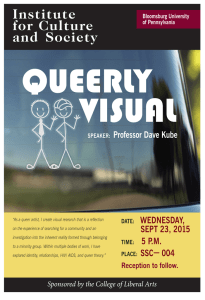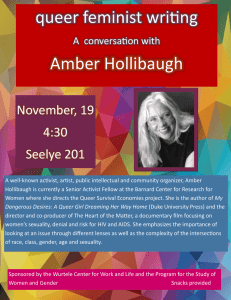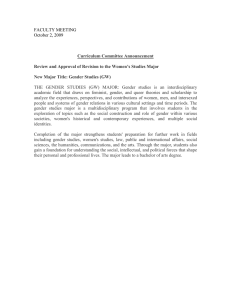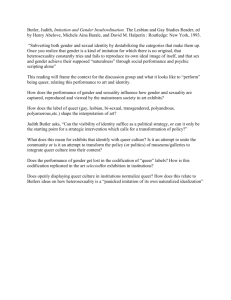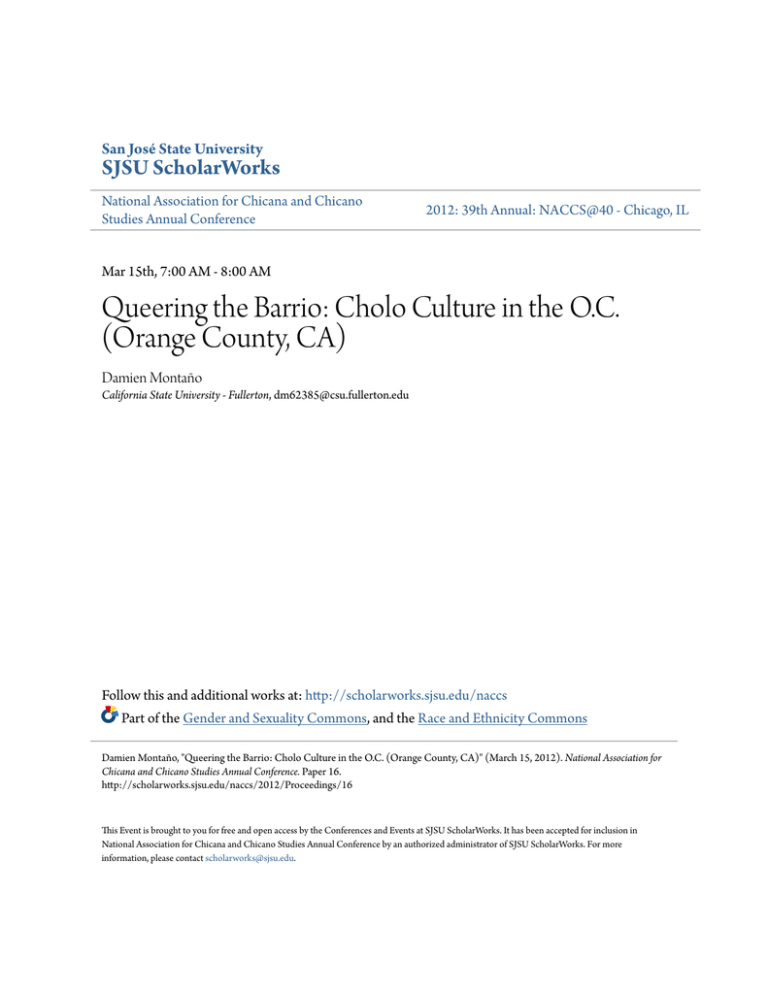
San José State University
SJSU ScholarWorks
National Association for Chicana and Chicano
Studies Annual Conference
2012: 39th Annual: NACCS@40 - Chicago, IL
Mar 15th, 7:00 AM - 8:00 AM
Queering the Barrio: Cholo Culture in the O.C.
(Orange County, CA)
Damien Montaño
California State University - Fullerton, dm62385@csu.fullerton.edu
Follow this and additional works at: http://scholarworks.sjsu.edu/naccs
Part of the Gender and Sexuality Commons, and the Race and Ethnicity Commons
Damien Montaño, "Queering the Barrio: Cholo Culture in the O.C. (Orange County, CA)" (March 15, 2012). National Association for
Chicana and Chicano Studies Annual Conference. Paper 16.
http://scholarworks.sjsu.edu/naccs/2012/Proceedings/16
This Event is brought to you for free and open access by the Conferences and Events at SJSU ScholarWorks. It has been accepted for inclusion in
National Association for Chicana and Chicano Studies Annual Conference by an authorized administrator of SJSU ScholarWorks. For more
information, please contact scholarworks@sjsu.edu.
“Queering the Barrio: Cholo Culture in the O.C. (Orange County, CA).”
Damien Montaño, California State University, Fullerton
Barrio communities that are often seen as inferior affect the shaping of our identity within
the Barrio. It has traditionally been a space and place of cultural safety where the Chican@
community has been able to flourish by maintaining tradition and creating new avenues to
express their cultural heritage. But who exactly is part of the “community”? Very rarely does one
pause to think that the Barrio is inhabited by Queer individuals who take part in everyday life of
the neighborhood-some involved in local clicas, where sexualities often lay hidden, unspoken of,
and in the shadows. The Barrio has been stigmatized and stereotyped by outside communities;
often misunderstood and moved to the margins are the queer cholos of various Orange County
Barrios affectionately called “La Naranja” where the focus of this research lies. It is here in this
essay where I explore who these individuals are, and how they balance their sexuality in the
Barrio. I draw from Chicana and Chicano, Urban, as well as Nepantla Studies as theoretical
frameworks and I follow a Cultural Studies approach similar to what Ricky T. Rodriguez does in
his text Next of Kin: The Chicano/a Family in Cultural Politics. Queer Chol@s in many ways
live in the borderlands of the barrio, mainstream society, and also the Queer community. Queer
Chicanos deal with being a part of numerous communities increasing the pressures they face
which is often discrimination from multiple sources. The identities of queer chol@s in the
Chican@ community shows that love, sexuality, and culture are intricately braided together and
the essences of both are manifested in the presence of the barrios queer inhabitants.
Although some can’t fathom the idea of two cholos sexually intertwined, or locked in a
passionate kiss, it seems quite fitting there would be a space for the “gay thug” amongst the
diversity of queer genres. Not all gay or lesbian, bisexual or transgender people identify as queer,
Montaño 1
just like not all Mexican people identify as Chican@. My informants had experienced the term
“queer” as well as a myriad of other slurs in a demeaning and negative context. The term queer, I
use throughout this paper from a position of power and pride implying a politic; a consciousness;
I use it in a way that not only refers to sexuality, but in a way that challenges and subverts
dominant hetero-normative models. The queer community faces struggles for human rights and
acceptance while many Latin@ and Chican@ youths face the challenges of being criminalized
and over-surveillanced by law enforcement within their cities. Queer chol@s are marginalized in
the fact that their very existence is questioned not only within the greater community but within
their respective neighborhoods and families leaving individuals feeling unable to express their
sexual feelings, identities and desires in a safe and nurturing space which the barrio is supposed
to be. Reactions from familia, society, and local clicas towards queer individuals can range from
acceptance to violence. It is well known that Chican@s have fought and struggled in order to be
incorporated into the American societal mainstream which has not always embraced them with
open arms. Queers and Chol@s have a history of being “shunned” even when their desire is
integrating into a community which at times can be hostile towards them.
Unfortunately, at times Orange County has been no different. Popularized by MTV’s
“The Hills” Orange County was depicted over mass media as a County of elites, wealthy living,
suburban homes and hugging the shores of Laguna Beach, when in stark reality the “real OC” is
found hugging freeway overpasses in the barrios of Fullerton, Santa Ana, and Placentia. Barrio
spaces often seen as inferior by outside communities affect the shaping of our identity in the
barrio. It has been a place of cultural safety where the Chican@ community has been able to
flourish by maintaining tradition and also creating new avenues to express their cultural heritage.
But who exactly is part of the “community”? Very rarely does one pause to think that the barrio
Montaño 2
is inhabited by queer individuals who take part in everyday life of the neighborhood-some
involved in local clicas, where sexualities often lay hidden, unspoken of, and in the shadows.
I remember my Nike Cortes wearing cholo days when I over-performed masculinities in
public and in private stared at the vatos in Teen Angel Magazines-not the beautiful muxeres on
the cover of Lowrider causing me to question my sexuality, and everything that had been taught
to me about the brown body. In his text Next of Kin, Ricky Rodriguez analyzes an interview in
the lowriding magazine Firme along with “Gay Ghetto District” by Joe Olvera saying “In both
texts, Chicano gay men function as a fetish for straight men, apparent in their interest in, and
curiosity about, what gay men do and how they do it.” (Rodriguez p. 156) One of my informants
was a retired homeboy from the Placentia barrio named Mario who today runs the barrios Old
Town Hair Salon and has ran it for the past 30 years. He revealed to me “the vatos would come
in for a trim and ask, ‘hey Mario how do you do this, or that?’ Then I would respond, ‘well take
me out to dinner and I’ll show you!’ That’s how I built their confianza, and they trusted me that I
wouldn’t out them to their homeboys. And some of these guys were the same ones who would
call me faggot or joto in front of their homeboys.” (Personal Interview with Mario) Throughout
discussions with Mario many instances arose where Chicano youth performed a very hard or
macho role in the public sphere, yet in private reveal another side of themselves. There are some
men who are curious, and when a queer individual is known in the barrio they are sought after
for guidance and for affirmation. Queer individuals, like Mario hold a legitimate and valid space
within our barrios-they play a very special role in our community because their existence allows
the next generation of queer youth to assert their identities in the barrio.
Montaño 3
Many barrios lack an open queer presence which causes youth to venture outside of the
barrio to experience “gay lifestyle”. It is in this arena where they can gain acceptance, but can
also experience discrimination amongst an affluent, white, male-dominated gay culture. It may
be difficult for queer Chican@ and Latin@ youth to see a queer community of color, and this is
where art serves a grand purpose. As Chican@s and as Indigenous people art is close to our
hearts. It is something ancient in us, from the sculptors of Mayan pictographs, the Mexica
muralists in Tenochtitlan, to Zuni elders working turquoise into squash blossom shaped amulets.
Vestiges of our artistic memory are found in Xican@ pop-culture, Lowrider Arte, tattoos, local
murals, and many other forms of Chican@ art found in today’s barrios. Not only does art create a
world which does not necessarily exist, but it also brings to the foreground that which is hidden
in the shadows of true existence. It is in this way that artists have big shoes to fill by producing
images which give life and flesh to our thoughts and ideas. Now, I seek the individuals who tell
Queerstory through diverse mediums of art.
In conducting this research I spoke with artist Manuel A. Acevedo who produces images of
the “clean cut” queer of color. The artist is based in Los Angeles, yet the theme he constructs
transmits to all barrios from LA to Orange County to barrios in Chicago. Acevedo has numerous
pieces which emphasize the brown body, several in particular which give emphasis to eyebrows
a term Rodriguez calls “queering the homeboy aesthetic”. In regards to these attributes today we
see many cholos and Chicano/Latino youth embracing the shaped/tweezed/plucked/threaded
eyebrow. Eyebrows are big in gang culture today for both vatos and rucas. They are similar to
our Indigenous tribal facial tattoos which have always been immediate signifiers of status. We
see this in more extreme cases such as the MS 13 gangs and prison gangs where tattoos are
applied to the face, for example a tear drop under the right eye, or one’s placa above a formed
Montaño 4
eyebrow. When a Chicana with defined eyebrows is seen, she may more than likely be identified
as a chola since they have long taken the lead in shifting the paradigms of gender. Muxeres wore
the vatos clothes such as sweaters and baggy jeans openly as an interview with Flaco states,
“I’ve known a lot more lesbians who are true warriors, who are truly down for their lifestyle.”
(Personal Interview with Flaco) The men more recently have embraced their eyebrows like their
feminine counterparts by accentuating them. In this artistic move they counter traditional cholo
masculinities by stepping out of constructed boxes of defined identity-all through their artistic
tool in this case the pinsas, not the paintbrush.
It seems clear that for queer chol@s art is a major form of expression. Hector Silva is an
artist whose work frees our minds from their boundaries focusing on hermandad and love shared
between the barrios queer inhabitants. When asked what his thoughts are on gay cholos he
replied, “Gay cholos exist, of course. Gay people are everywhere. Some are in gangs. Cholos are
a sexual fantasy for many people, myself included, so I draw them in erotic situations for my
erotic art.” (Personal Interview with Hector Silva) It is in this way that Silva represents the
individual at the intersections of culture and sexuality. Silva exclaims “Art should move the
body, not just high-minded, transcendental, intellectual stimulation.” (Personal Interview with
Hector Silva)
Being a queer Chol@ or being queer in general, one must learn to navigate through various
spaces while staying tied to their identity whether that is sexual, cultural, or spiritual. As revealed
through spoken word my interviewee Mario revealed to me when asked about the meaning of his
tattoos he points to three dots on his fingers and a cross on his hand: “My Crazy Life, and “may
God be with me…It was an adventure to be with a homeboy, I never knew if that was going to
hurt me or not, ya’ know what I mean? I had the cross with me, and the Lord with me....I took a
Montaño 5
challenge to be with a homeboy.” (Personal Interview with Mario) The secret lifestyle which is
led by many Gay cholos is complex as they search the barrio for queer spaces. Queer cholos have
their role to play in Chican@ barrios across La Naranja by reinstituting a feminine/Queer
balance within the hearts of the Barrios inhabitants.
As Queer Chican@s we defend our sexuality and gender to the communities we belong to,
our spirituality to organized religion, our Native thought to non-Indigenous cultures, and our
traditions to society. We as Xican@ people will defend what is ours, even if it is a handful of
earth. Queer chol@s are marginalized in the fact that their very existence is questioned not only
within the Chican@ community but within their respective neighborhoods and families leaving
individuals feeling unable to express their sexual feelings, identities and desires in a safe and
nurturing space which the barrio is traditionally thought of. Reactions from familia, society, and
local clicas towards queer individuals can range from acceptance to violence. Life in the barrio
as a queer cholo is all about subverting hetero-normativities. I reflect about how queer
individuals have lived in our barrios, and how difficult it is for them to be accepted. These are
painful manifestations of colonization which causes raza to attack raza, and violence in its many
forms continues to be an issue that both barrio and queer communities deal with on a day to day
basis. The bridging of these two communities can be a road path to healing and the creation of a
space where queer children of the barrio can exist in peace.
Montaño 6
References
Personal Interview w/ Flaco December 2011
Personal Interview w/ Mario January &March 2012
Personal Interview w/ Manuel A. Acevedo February 2012
Rodriguez, Richard T. Next of Kin: The Family in Chicano/a Cultural Politics. Duke
University Press. 2009
Montaño 7

